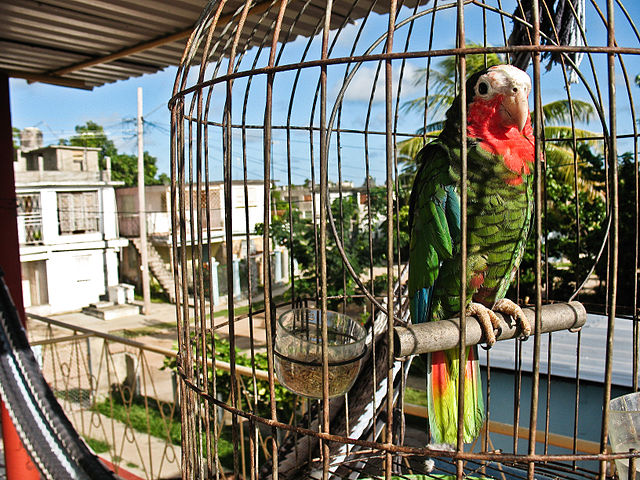Many owners of companion parrots work full-time jobs and have active social calendars. This means that the cage is where most birds wind up spending the majority of their time. When we aren’t available to give them abundant out-of-cage time, we must make sure that a cage is a place that offers lots of entertainment, comfort, and safety. The cage should be an enjoyable place to be.
Size dimensions: Your amazon is an active bird that will make use of every inch of its cage. As amazons are prone to obesity, it is important that you provide on the offers lots of space for climbing, vigorous wing flapping, and acrobatics during play – the three main ways your amazon will get exercise while inside the cage.

Always think bigger is better when selecting a cage for an amazon. Being a medium-sized bird with a wingspan of roughly 20″, the minimum cage dimensions should never be less than 30″ width by 24″ diameter by 30″ height for this species. This allows for the wings to be fully extended in either direction and allows clearance for toys and perches, but it should be considered the bare minimum in terms of space.
Bar spacing: For a blue fronted amazon, the bar spacing should be about 1″. Keep in mind that spacing that is too close together can result in toes being caught and injured during climbing and bar spacing that is too wide can catch wings and heads!
Cage Quality
It goes without saying that you should select the best quality cage you call afford. Cages should be powder coated or made from a non-toxic metal such as stainless steel. It should be sturdy in construction, without areas where toes wings or even tongues can become lodged. It should have locking mechanisms that can’t be defeated by your bird and feeding stations that open outward for safety and convenience.
Be sure to select a cage that is easy to clean – you will spend a lot of time doing just that. It is imperative to keep the bird’s environment free from the bacteria that grow in old, discarded food. Excessive dried fecal matter presents airborne health risks to both birds and humans.
Cage Placement
Amazon parrots are very social creatures who enjoy being a part of their family’s daily life and activities. To keep your bird well-socialized and entertained, be sure to keep the cage in an area well-traveled by the family.
Avoid drafty locations, such as by leaky windows and always be aware of what your parrot sees from his cage. The skylight, for instance, that gives a clear view of hawks flying overhead will cause your bird a lot of stress that might lead to fearfulness, screaming, and aggression. The cage should be a place where your blue fronted amazon feels totally safe and secure.
Perching
Since your parrot is on its feet 24/7, the perches you select for the cage are crucially important. Dowel-type perching for the average blue fronted amazon should be about 3/4″ to 1″ in diameter. You will know the perch is the right size for your bird when the foot wraps 3/4 of the way around it. However, your bird needs perches throughout the cage that vary in size, shape, and texture to maintain good foot health.
Toys and Enrichment
Parrots are highly intelligent creatures. Science has recently begun to compare their intelligence with that of small primates. Both in the wild and in captivity, they have shown an ability to use tools and practice manipulative and deceptive behaviors to their own ends. And anyone who has a parrot has experienced what can only be described as a sense of humor. Parrots are thinkers.
Consider, then, what it would be like to be an intelligent being locked in a cage all day with absolutely nothing to do to keep mentally stimulated. Consider yourself sitting in an empty room all day, every day. It wouldn’t be much of a life, and after a while, one of two things would happen – either you would descend into depression or you would become fighting mad. You could expect a similar decline in the emotional health of a bird.
It is your duty as your bird’s caregiver to be sure that there are a variety of toys always present in the cage. Toys come in many different forms. Some are there to satisfy a bird’s innate need to chew, others provide foraging opportunities. Some present challenges to keep a mind active. They all help fill the hours while a certain feathery roommate awaits your arrival home from work.
Training is a major source of enrichment. It includes all the most important aspects of the type of interaction your bird most needs and wants from you. It is uninterrupted one-on-one time with you. It involves direct eye contact and conversation where your focus is solely on your bird. Most importantly, there is the meeting of the minds between yourself and your bird: a mutual understanding of the goals that are set and reached, and the sense of accomplishment that goes with that.
